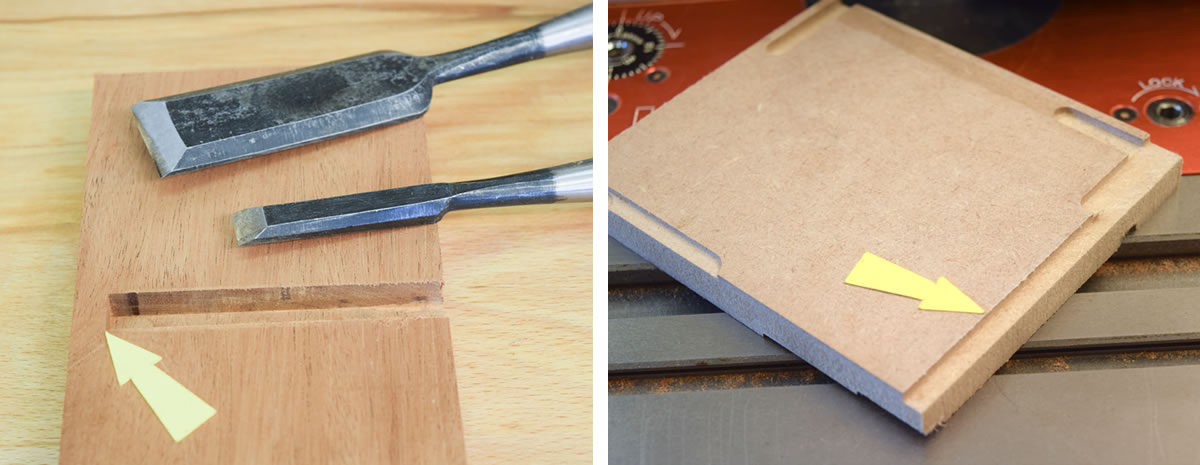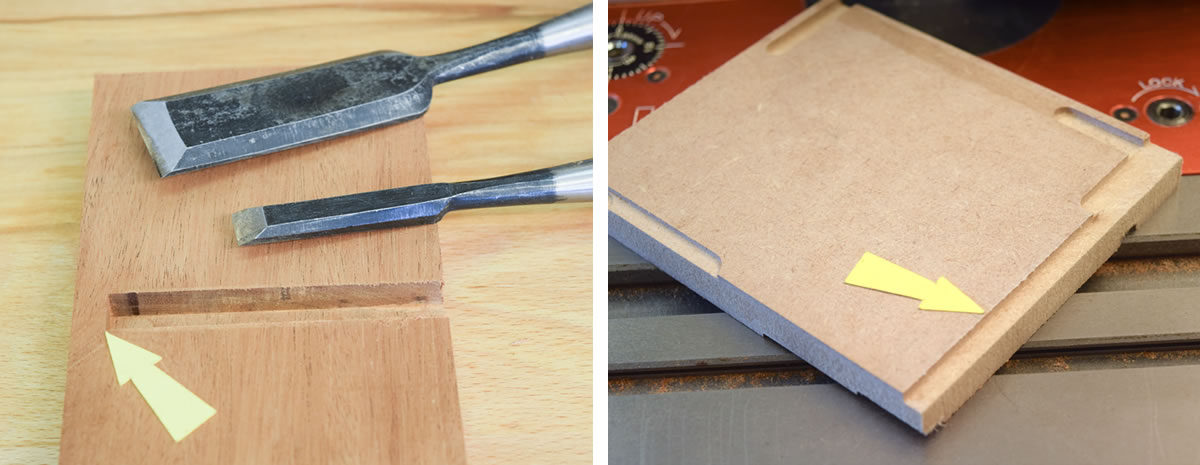If you’ve ever wondered, “Can you chisel MDF?” – you’re in the right place! Woodworking can be a fascinating hobby, and MDF, or Medium Density Fiberboard, is a popular material to work with. In this article, we’ll explore the possibilities of chiseling MDF and discover some helpful tips and tricks along the way.
Chiseling is a technique that allows you to shape and carve wood, creating intricate details and unique designs. But what about MDF? Can you use a chisel on this engineered wood product? The answer is yes, absolutely! While MDF may not have the same characteristics as solid wood, it can still be chiseled with care and precision.
So, if you’re ready to dive into the world of chiseling MDF and explore the endless creative possibilities, let’s get started! Whether you’re a woodworking enthusiast or just curious about the art of chiseling, this article will provide you with the information you need to tackle your next project with confidence.

Can You Chisel MDF?: A Comprehensive Guide
MDF, or Medium Density Fiberboard, is a popular material used in various woodworking projects due to its affordability and versatility. One common question that arises when working with MDF is whether it can be chiseled effectively. In this article, we will explore the possibilities of chiseling MDF and provide you with all the information you need to know. Read on to discover the techniques, tips, and considerations for chiseling MDF.
1. Understanding MDF and its Properties
MDF is an engineered wood product made by breaking down hardwood or softwood residuals into wood fibers, often combined with resin and wax. It is created by compressing the wood fibers under high pressure and temperature to form a dense, uniform material. The result is a board that is smooth, flat, and consistent in thickness.
When it comes to chiseling MDF, it is essential to understand its properties. MDF is a relatively soft material compared to solid wood, making it easier to work with hand tools like chisels. However, due to its composition and uniform density, MDF tends to be more brittle and prone to chip-out. This means that extra care needs to be taken when chiseling to avoid damaging the material.
2. Choosing the Right Chisel for MDF
To achieve clean and precise chiseling results with MDF, it is crucial to choose the right chisel for the job. Firstly, ensure that your chisel is sharp and properly honed. Dull or improperly sharpened chisels can increase the risk of splintering and chipping.
For chiseling MDF, be sure to select a chisel with a beveled edge, as this design allows for greater control and reduces the chance of tearing the material. A chisel width between ¼ inch to 1 inch is suitable for most MDF applications. Additionally, consider using a chisel with a high-quality handle that provides a comfortable grip and minimizes hand fatigue during extended use.
3. Techniques for Chiseling MDF
When it comes to actually chiseling MDF, there are a few techniques that can help you achieve the best results. Here are some key points to keep in mind:
1. Mark your chiseling area: Use a pencil or marking knife to clearly outline the area you intend to chisel. This will help you stay within the desired boundaries and prevent any accidental damage to the surrounding areas.
2. Start with light cuts: Begin by making shallow, light cuts with your chisel. This allows you to establish the desired shape and depth gradually, reducing the risk of chipping or splintering.
3. Use a mallet or hammer: To provide controlled force, use a mallet or hammer to strike the chisel gently. Avoid using excessive force, as this can cause the MDF to crack or split.
4. Take multiple passes: Instead of trying to remove a large amount of material in one go, make multiple passes with your chisel. This will help prevent chipping and give you better control over the process.
5. Support the MDF: To minimize vibrations and prevent the material from tearing out, support the MDF by placing scrap wood or a sacrificial backing underneath the workpiece. This provides added stability and reduces the risk of tear-out.
With these techniques in mind, you can confidently chisel MDF and achieve clean and precise results. Remember to take your time and practice on scrap pieces before working on your final project to gain more experience and improve your skills.
Best Practices for Chiseling MDF
1. Safety First
As with any woodworking task, safety should always be a top priority. When chiseling MDF, it is important to wear appropriate safety gear, including safety glasses, a dust mask, and hearing protection. MDF produces fine dust particles when worked on, which can be harmful if inhaled. Therefore, ensure that you work in a well-ventilated area or use a dust collection system to minimize exposure.
2. Considerations for Chiseling MDF
Chiseling MDF requires some additional considerations due to its unique properties. Here are a few tips to keep in mind:
1. Grain orientation: Unlike solid wood, MDF does not have a grain pattern. As a result, you can chisel in any direction without worrying about grain direction. This makes it easier to work with and allows for more design flexibility.
2. Surface preparation: Before chiseling, ensure that the surface of the MDF is smooth and free of any imperfections. Sanding the area lightly with a fine-grit sandpaper can help achieve a cleaner finish.
3. Prevention of tear-out: To prevent tear-out or chipping when chiseling across the grain, score the area lightly with a utility knife before chiseling. This weakens the fibers and reduces the risk of tear-out.
4. Practice patience: Chiseling MDF requires patience and a steady hand. Take your time and work slowly to achieve the desired results. Rushing through the process can lead to mistakes and compromised quality.
Common Mistakes to Avoid when Chiseling MDF
1. Improperly sharpened chisel
One of the most common mistakes when chiseling MDF is using a dull or improperly sharpened chisel. A dull chisel can cause the MDF to splinter and chip, resulting in a less clean and precise cut. Always take the time to ensure that your chisel is properly sharpened before starting your project.
2. Using excessive force
Another mistake to avoid is using excessive force when chiseling MDF. MDF is a relatively soft material, and applying too much force can cause it to crack or split. Instead, use controlled and gentle strikes with a mallet or hammer, allowing the chisel to cut through the material gradually.
3. Rushing the process
Chiseling requires patience and precision, especially when working with MDF. Rushing through the process can lead to mistakes, uneven cuts, and compromised quality. Take your time, make light cuts, and work slowly to achieve the best results.
By following these guidelines and avoiding common mistakes, you can successfully chisel MDF and achieve clean and precise results. Remember to practice on scrap pieces before working on your final project to improve your skills and gain more confidence in your abilities.
Can You Chisel MDF? – Key Takeaways
- Chiseling MDF is possible, but it requires special techniques.
- Ensure you have sharp chisels to prevent splintering.
- Take your time and make shallow cuts, gradually going deeper.
- Consider using a router or power tool for more precise results.
- Practice on scrap pieces before working on your final project.
Frequently Asked Questions
Welcome to our FAQ section on chiseling MDF! Here, we have compiled some common questions about working with MDF and using chisels. Whether you’re a beginner or an experienced woodworker, we hope these answers help you navigate the world of MDF and chiseling.
1. Can you use a chisel on MDF?
Absolutely! You can use a chisel on MDF. However, it’s important to note that MDF (Medium Density Fiberboard) is a composite wood material that consists of compressed wood fibers and resins. Since MDF is denser and more uniform compared to solid wood, you may find that it requires slightly different techniques when using a chisel.
When chiseling MDF, it’s important to have a sharp chisel and use controlled, steady force. Avoid applying excessive pressure, as MDF can be more prone to splitting or breaking compared to solid wood. Additionally, it’s a good idea to practice on scrap pieces of MDF before working on your final project to get a feel for how the material responds to the chisel.
2. What type of chisel should I use for MDF?
For chiseling MDF, a sharp bench chisel or a beveled edge chisel is commonly used. These chisels have a flat and straight cutting edge, making them suitable for working with MDF’s smooth and uniform surface. It’s important to keep the chisel sharp at all times, as a dull chisel may cause more tear-out and splintering of the MDF.
Additionally, consider the width of the chisel blade. A narrower chisel may be more suitable for precision work, while a wider chisel can quickly remove larger amounts of material. Choose a chisel width that aligns with your project requirements. Remember to always use tools that are in good condition and designed for woodworking to ensure safe and effective chiseling.
3. Should I treat the edges of MDF before chiseling?
While treating the edges of MDF is not mandatory, it can help reduce tear-out and create cleaner cuts when chiseling. MDF has a tendency to have rough edges, which can be more susceptible to splintering. To minimize this, you can seal the edges of the MDF by applying sanding sealer, paint, or wood glue and allowing it to dry before chiseling.
Sealing the edges helps to strengthen the fibers and prevent them from loosening during the chiseling process. It also provides a smoother surface for the chisel to work on. However, if you prefer the raw appearance of the MDF edges or your project requires it, you can choose to skip this step and proceed with chiseling directly.
4. How do I prevent tear-out when chiseling MDF?
Tear-out, where the fibers of the MDF pull away or splinter, can be minimized by using the proper chiseling techniques. First, ensure your chisel is sharp and well-maintained. A dull or damaged chisel is more likely to cause tear-out.
When chiseling, work with the grain of the MDF, making shallow cuts and gradually deepening them. Avoid digging the chisel too deeply in one pass, as this can increase the likelihood of tear-out. Going slowly and using controlled pressure will help achieve cleaner and more precise cuts without excessive tear-out.
5. Are there any safety precautions I should take when chiseling MDF?
When chiseling MDF, it’s important to wear appropriate safety gear such as safety glasses to protect your eyes from flying debris. As MDF can generate fine particles and dust, consider wearing a dust mask to prevent inhaling the particles.
Additionally, ensure you have a stable work surface and a secure grip on the piece of MDF to prevent slips that may cause injuries. Take your time and work deliberately, focusing on accuracy and precision. With the right safety precautions, chiseling MDF can be a safe and rewarding woodworking experience.

What can you do with a chisel?
Summary
Basically, you can chisel MDF, but it’s not the easiest material to work with. MDF is a type of engineered wood made from compressed fibers, which means it’s not as strong as real wood. However, with the right tools and techniques, you can achieve good results. Just remember to use sharp chisels and take your time to avoid splintering the MDF. It’s also important to wear safety goggles and a dust mask to protect yourself from the fine dust that MDF produces.
